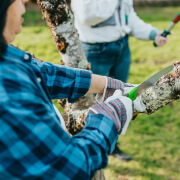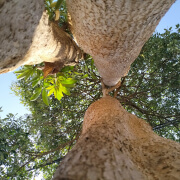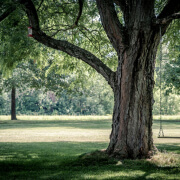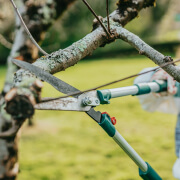How Tree Lopping Prevents Property Damage
Tree lopping is more than just an aesthetic touch-up for your garden. It plays a pivotal role in maintaining the health of your trees and the safety of your property. Imagine large branches hanging precariously over your roof or driveway; these are risks waiting to happen. In Brisbane, with its distinctive climate and weather patterns, managing tree growth requires a careful approach. It’s not just about keeping your landscape beautiful but also about preventing damage and ensuring safety.
Why should you care about lopping your trees? Besides the obvious danger of falling branches during storms, there’s a hidden world of benefits that come from regular pruning. By removing sections of a tree that may pose threats, you’re not only safeguarding your home but also fostering healthier tree growth. The balance is in knowing when and what to lop, aligning your efforts with the climate-specific challenges of Brisbane. Let’s explore further how tree lopping is crucial in protecting your property.
The Role of Tree Lopping in Preventing Property Damage
Overgrown branches are not just unsightly; they can be a real hazard. When left unattended, these limbs can interfere with power lines, obscure visibility on streets, or, worse, cause physical damage to homes and cars. In Brisbane, where unpredictable weather is common, especially during the stormy season, overgrown branches are an invitation for trouble.
Consider this scenario: strong winds whip through the city, carrying with them heavy rain. A branch that hasn’t been lopped in time comes crashing down on a neighbour’s car. Not only is this a costly affair, but it could also have been easily avoided with timely tree maintenance. The main risks associated with overgrown branches include:
– Damage to roofs and gutters
– Interference with power lines and potential fire hazards
– Cracks in walkways and driveways from root expansion
Each of these can lead to expensive repairs or, worse, safety hazards. By keeping your trees in check, you ward off these threats and maintain the harmony of your outdoor spaces. By addressing these potential dangers early, you protect not only your own property but the overall safety of your neighbourhood.
Tree lopping doesn’t just prevent immediate damage. It also keeps your trees healthier, meaning there’s less chance of disease taking over and weakening structures further. In Brisbane’s urban environment, where gardens are often compact, a fallen tree or branch can lead to significant disruption. Regular lopping ensures robust health for your trees, allowing well-maintained foliage to withstand whatever nature throws at them.
Health Benefits for Trees
Tree lopping isn’t just about removing potential hazards; it also contributes significantly to the well-being of the trees themselves. Regular lopping encourages healthier growth by allowing trees to channel their energy and nutrients to the strongest sections. This makes trees more resilient and robust against pests and diseases, reducing the risk of falling branches. In turn, healthier trees mean fewer problems for property owners.
For those in Brisbane, common species such as Moreton Bay fig and Queensland bottle tree greatly benefit from regular maintenance. These trees, when correctly lopped, can enjoy enhanced growth and longevity. With fewer dead or decaying branches, trees are less likely to topple or lose limbs during heavy winds. Regular lopping thus acts as a protective measure, ensuring trees remain strong and sturdy year-round.
Seasonal Considerations for Effective Tree Lopping in Brisbane
In Brisbane, understanding the best times of year for tree lopping can make all the difference. The city’s climate, characterised by its wet summers and mild, dry winters, means some seasons are more favourable for lopping than others. Generally, cooler months, such as autumn and winter, are ideal since the trees are less stressed and can heal more quickly from the cuts.
Seasonal patterns also affect tree growth and potential risks. During Queensland’s wet season, trees can grow rapidly, which might lead to more branches becoming overgrown and hazardous. Conversely, during the dry months, maintaining tree hydration while avoiding unnecessary stress from lopping is crucial. Here are a few tips to help schedule your tree lopping activities effectively:
– Autumn and winter are usually best for major lopping and pruning.
– Spring lopping should be minimal, focusing only on dead or dangerous branches.
– Avoid heavy lopping during the summer’s peak as trees can be stressed from the heat.
Being aware of these seasonal impacts ensures your trees are cared for properly, without putting them or your property at risk.
Choosing Professional Tree Lopping Services in Brisbane
When it comes to tree lopping, safety, and efficiency should be top of mind. Professional services offer expertise in identifying which branches pose risks and how best to manage them without causing harm to the tree or property. Professionals not only ensure that branches are safely removed but also consider the overall health of the tree.
Finding a reliable service means looking for teams with solid reputations and plenty of experience handling local tree species. Ideally, choose those who understand Brisbane’s unique conditions and can offer personalised advice. By hiring professionals, you gain peace of mind knowing your trees are handled with care, reducing the likelihood of unexpected property damage.
Keeping Your Property Safe with Regular Tree Lopping
Regular tree lopping is more than just routine maintenance; it’s a proactive step in ensuring safety and peace of mind. By keeping your trees in shape, you’re essentially safeguarding your home from potential accidents and unforeseen expenses. Healthy, well-maintained trees not only enhance the aesthetic appeal of your property but also contribute to the safety of your neighbourhood.
As we’ve highlighted, the benefits of tree lopping, from enhancing tree health to preventing property damage, are numerous. Taking the time to understand your trees and the best times to manage them can prevent many potential headaches down the line. Don’t leave your trees’ health to chance; ensure they’re regularly inspected and maintained.
Keep your trees in top shape and avoid the pitfalls of neglect by prioritising tree lopping in Brisbane. To see how TPS Tree Services can help you maintain a safe, tidy, and thriving outdoor space, explore the solutions tailored to your needs. With expert support, you can enjoy peace of mind knowing your property is well looked after year-round.









